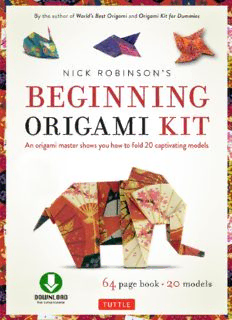
Nick Robinson’s Beginning Origami Kit: An Origami Master Shows You How to Fold 20 Captivating Models PDF
Preview Nick Robinson’s Beginning Origami Kit: An Origami Master Shows You How to Fold 20 Captivating Models
Contents Introduction How to Fold & Choosing Paper My Folding Philosophy Origami Techniques Leaf Snails in Love Star Form Freiburg Dish Arrowhead Tessellation Baby Rabbit Heart Card Business Card Holder Pecking Bird Angel Cat Brooch Woodpecker German House Elephant Flexi-Fish Form Styracosaurus Frog Time for Lunch Buddha’s Head Arlington Box What to Do After Completing This Book? How to Download the Bonus Material of this Book. 1. You must have an internet connection. 2. Click the link below or copy paste the URL to your web browser. http://www.tuttlepublishing.com/beginning-origami-kit-downloadable-cd- content For support email us at [email protected]. Contents - Audio Files (.mp3) - Folding Papers (.pdf) Disclaimer: "Please check the audio and video specifications of your ebook reader before downloading any additional content." Introduction Like any art form, origami encompasses a wide range of different styles; from simple to complex, from realistic to caricature, from geometric to organic. Throughout the thirty years I have been folding paper, my creations have moved further and further toward the simple end of the spectrum. Every fold must earn its place and the end result should be elegant, thoughtful and clean. Origami, in my view, is about reducing a subject to basic elements; to capture the essence with as few folds as are necessary. Technique should never get in the way of artistry! This book presents a selection of my designs representing my vision of origami. I appreciate many different styles of folding, but I believe you should always follow your instincts when creating. Don’t produce work with the aim of impressing other people. Inevitably, you will discover many models that do not meet your own standards. These should be set aside; maybe you can further refine them later. It is only by being ruthlessly self-critical that you can improve the quality of your output. As I grow older, I spend more time thinking and talking about origami as well as folding it. One topic that frequently returns is that of origami as a process as well as an end result—is origami a journey, or a destination? For the folder, the process of folding is a direct relationship with the paper. Once complete, there is little you can do with a model, apart from display it or give it away. In some ways, it can be seen as a by-product of the folding. For this reason, I spend a great deal of time looking at the folding process. I assess the various ways of achieving each step, choosing the one I feel makes the folding more intriguing, more elegant, more fluid. It isn’t possible with every step, but it’s a guiding tenet. I also believe that a creator’s work should reflect aspects of their personality and life. There is no reason why a model cannot make a statement, or contain humor, or reflect other passions you may have in life. My aim is to create designs that communicate with people, to make them smile, remember an experience or simply to enjoy a moment of shared humanity. How to Fold Folding paper neatly and accurately isn’t always easy for newcomers to origami. However, there’s no good reason why you can’t improve, no matter how little confidence you have. Here are a few simple tips: Fold slowly; it’s not a race. You will get much better results. Fold the paper away from you rather than toward you (where you hands can get in the way). Set aside plenty of time to fold; it’s not good for your concentration if you have distractions. Fold at a well-lit table, with enough space for your elbows. Make all creases sharp to begin with, making sure the paper is perfectly positioned before flattening. Make each model at least three times using cheaper paper before using your best paper. Cut the paper very accurately if you make your own squares from a larger sheet. A rotary trimmer is a good investment. Fold in a small group. It’s fun and will also teach you a lot in a short time. Teach the model to other people. It will really help your understanding of the folding sequence. Choosing Paper Origami usually requires paper that is perfectly square. When you have used all the sheets in this kit you’ll need to source your own paper. There are lots of options for “proper” origami paper (which can be bought cheaply on the Internet), but you can also choose from many other types
Description: